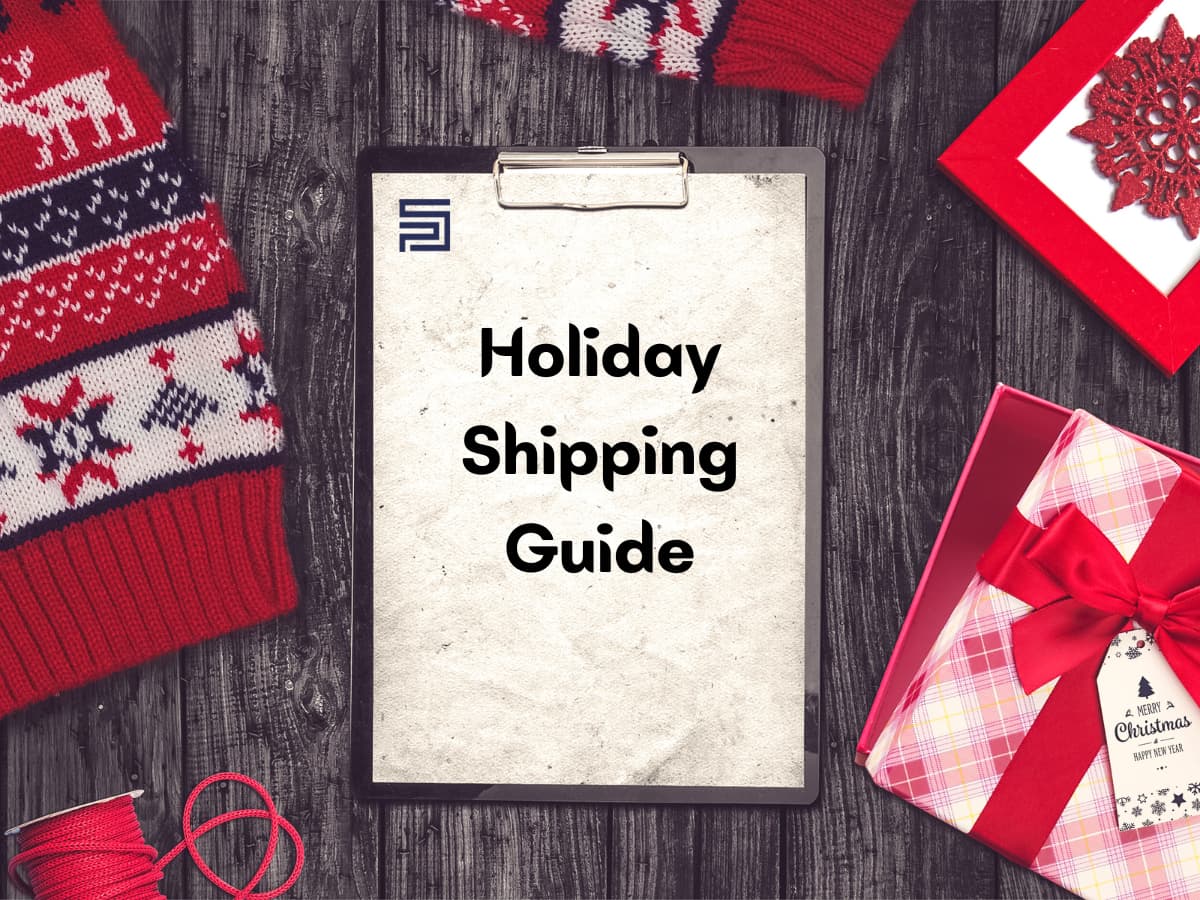Need your holiday shipments to arrive on time?
You're in the right place.
At SARA, we've handled over 189,000 shipments in the past 20+ years, and we know exactly what it takes to get your packages delivered before the big day.
Contact our team now and let's ensure your holiday deliveries arrive exactly when you need them.
In this comprehensive guide, we'll show you the exact cutoff dates for shipping, how to avoid costly peak season surcharges, and the specific steps we use to clear our clients’ holiday packages through customs faster.
Why Holiday Shipping Planning Matters
Here's what happens during peak season that most businesses don't prepare for:
1. Volume Surge:
Carriers handle 40-60% more packages than usual. This isn't just numbers; it means longer processing times and higher chances of delays.
2. Peak Season Surcharges:
We've seen businesses get hit with unexpected fees ranging from $1.50 to $6.50 per package. These charges can double your shipping budget if you don't plan.
3. Customs Backlogs:
In December 2024, we saw customs clearance times in Nigeria increase from our usual average of 7 days.
Why? Holiday volume, reduced staffing, and some banks' inefficiency, according to Guardian Nigeria News.
4. Capacity Limits:
Popular services like DHL Express and FedEx Priority often reach capacity weeks before their official cutoff dates.
For businesses shipping to and from Nigeria, these challenges get worse because of documentation requirements, customs processing times, and limited carrier options for this route.
But here's the good news: with proper planning, you can avoid most of these problems.
Holiday Shipping Planner || Critical Cutoff Dates and Deadlines
At SARA, over 70% of the shipments we handle move along the China ↔ Nigeria route.
With years of experience navigating this route, through both peak holiday rush and regular seasons, we’ve identified the key cutoff dates you should plan around.
These dates can make the difference between your goods arriving on time or getting stuck in the backlog.
Cutoff Date for Air Freight China to Nigeria:
If you need your goods delivered on or before December 25th, you should plan for your shipment to leave by December 15th at the latest.
On average, it takes about 10 days to ship goods from China to Nigeria via air freight during the holiday season. If you’re using express shipping, transit time can be as short as 5 days.
The rule of thumb is simple: work backward from your delivery date. Subtract 10 days (or 5 for express) to know the latest safe shipping date. This way, you stay ahead of holiday congestion and avoid last-minute surprises.
Key Note for Holiday Air Freight:
Standard Air Cargo: ~10 days during the holiday season
Express Shipping: ~5 days
Plan Ahead: If you need delivery by December 25th, ship no later than December 15th (or December 19th for express).
Cutoff Date for Sea Freight China to Nigeria:
For sea shipments, transit times are much longer, up to 3 months for goods to arrive from China to Nigeria.
That means if you need your shipment delivered before December 25th, it should leave no later than October 10th (and earlier is even better).
Because ocean freight requires such early planning, you’ll want to be strategic with your planning.
Consolidate all the goods you’ll need for the season into your October shipment. Any items you leave out will most likely have to wait until the new year.
Key Note for Holiday Sea Freight:
Transit Time: ~3 months (90 days)
Plan Ahead: To meet the December 25th deadline, ship no later than October 10th (earlier is safer).
Strategy Tip: Consolidate all goods in your October shipment; anything left behind will likely be carried over to the new year.
Do you want specific dates for your shipping routes? Contact our team, and we will provide the planning dates for your business.
How To Choose The Best Carrier & Service During Holiday Seasons
We’ve shipped on every route and through every season, including the busiest holiday spikes.
During these times, we usually consider the following before picking a service for the shipment:
- Urgency: gift vs non-critical inventory
- Value: high-value items need better tracking & insurance.
- Weight & volume: parcel, pallet, or full container changes the mode.
- Customs complexity: documentation, HS codes, and duties add time.
- Budget: cost vs acceptable risk of late delivery.
Through this evaluation, we can match every client with the service that best fits their specific needs.
For example, if the delivery date is non-negotiable, we choose express service and buy insurance, or if cost is primary and date is flexible, we consolidate & use economy air or sea (but booking early is essential).
If you’re unsure about any of these, reach out to our expert team at SARA. We can run a free shipment audit to recommend the optimal service and timeline.
Packaging Best Practices For Holiday Shipment || Practical Checklist
Polished, carrier-friendly packaging keeps your goods safe and speeds clearance. Follow this checklist to pack up goods.
Box selection & strength:
Use new corrugated cardboard boxes sized to fit the product + cushioning.
For items > 20 lb or fragile items, choose double-wall boxes.
Minimum strength: 32 ECT (edge crush test) for standard parcels; choose higher for heavy/stacked loads.
If palletising multiple boxes, make sure the box strength and stacking rating match the pallet load.
Interior protection (cushioning & packing):
Wrap each fragile item individually (bubble wrap, foam wrap, or corrugated inserts).
Fill voids with air pillows, foam, or packing peanuts so items do not shift.
Maintain 2–3 inches of cushioning around all fragile items.
Place heavy items at the bottom; lighter/fragile items on top.
Use dividers for multiple items in one box to avoid contact.
Sealing technique (do it right, every time):
Use pressure-sensitive plastic packaging tape, minimum 2" (50 mm) wide.
Apply tape in an “H” pattern: tape the centre seam and both long edges of the box top (and repeat on the bottom).
Avoid using string/twine, masking tape, or duct tape. Many carriers will refuse these.
For heavy loads, add strapping or extra tape seams as needed.
Labelling & handling marks:
Ensure the shipping label is flat, scannable, and placed on the largest box surface.
Include “FRAGILE”, “THIS SIDE UP”, or “DO NOT STACK” only when accurate. Over-labelling reduces credibility.
Add a duplicate label inside the box (in a plastic sleeve) for lost/exposed labels.
International Shipping Documentation Essentials For Holiday Shipping
- Commercial invoice.
- Packing list.
- Import license.
- Proforma invoice.
- Shipper’s letter of instruction.
- Certificate of origin.
- Dangerous Goods Declaration Forms (if applicable).
- Export clearance forms (for export only).
Nigeria-specific documents & compliance notes
- SONCAP
- DPR Product Certificate
Common documentation mistakes (avoid these)
- Using vague descriptions (e.g., “parts”)
- Missing HS codes or incorrect country of origin
- Declaring incorrect values (under- or over-declaring)
- Forgetting required certificates (e.g., SONCAP, phytosanitary, COA)
You can check out our comprehensive guide on shipping documents for details on each document.
Gift Shipping Rules For Holidays
Items You CAN Ship as Holiday Gifts:
- Clothing and accessories (under duty-free limits).
- Electronics (with proper documentation).
- Books and educational materials.
- Non-liquid cosmetics.
- Packaged food items (following regulations).
Items That Cause Problems:
- Liquid perfumes (hazmat restrictions).
- Homemade food items (health regulations).
- Anything plant-based without certificates.
- Electronics without proper invoicing.
Want to verify if your specific items can be shipped? Contact our team, and we'll check the regulations for your destination.
Common Holiday Shipping Problems We See
After handling thousands of holiday shipments, here are the problems we see businesses face most often:
1. Peak-volume congestion (capacity & transit slowdowns)
Why it happens: Carriers, ports, and airports operate at near-capacity during the holiday rush, causing longer transit times and delayed departures.
How to avoid it
- Plan earlier: Move reorder points forward; book shipments well before peak weeks.
- Choose the right mode: Use express/air for time-critical items; consolidate sea for non-urgent, high-volume loads.
- Spread shipments: Stagger departures to reduce the risk of a single delayed window affecting all orders.
2. Missed carrier cutoff dates & confusion over service windows:
Why it happens: Businesses confuse “last drop-off” with ETA or assume normal transit times during peak season.
How to avoid it
- Use a ship-by calendar: Publish and follow explicit ship-by dates for each service level and destination. You can speak to our team to get ours.
- Add a buffer: Build 24–72 hour buffers on top of carrier cutoffs to cover local pickup and processing time.
- Automate reminders: Use notifications to warn warehouse and sales teams when ship-by windows are approaching.
3. Customs delays & incorrect documentation:
Why it happens: Missing HS codes, incorrect values, or absent certificates (e.g., SONCAP) cause holds at customs.
How to avoid it
- Complete paperwork before booking: Commercial invoices, HS codes, COO, and required certificates should be ready at booking.
- Validate HS codes and values: Use experienced customs agents or SARA’s documentation review service.
- Use correct Incoterms: Be clear on who is responsible for duties and taxes.
4. Damaged or improperly packaged goods:
Why it happens: Weak boxes, insufficient cushioning, or poor palletization during high-handling periods.
How to avoid it
- Follow packaging standards: Double-wall boxes for heavy items, 2–3 inches of internal cushioning for fragile items, and proper pallet straps.
- Test your pack: Simulate rough handling or drop tests for fragile SKUs.
- Label properly: Use clear handling instructions and durable labels.
5. Unexpected peak surcharges & rate volatility
Why it happens: Carriers sometimes apply peak-season or capacity surcharges with little lead time.
How to avoid it
- Lock rates where possible: Negotiate contracts or spot-book earlier to reduce exposure.
- Model total landed cost: Include potential surcharges in product pricing and shipping options.
6. Weather disruptions & force majeure events
Why it happens: Storms, floods, or other natural events delay flights, vessels, and ground transport.
How to avoid it
- Monitor weather forecasts on critical lanes.
- Have contingency plans: Pre-book alternate routings where possible.
- Communicate with customers early about potential delays.
7. Tracking blind spots & mis-scans
Why it happens: High volumes and manual scans can cause missing or stale tracking updates.
How to avoid it
- Choose carriers with reliable tracking APIs.
- Implement exception alerts: Trigger notifications for “no-scan” or delayed status beyond 7 days.
- You can also use the utility SARA tracking tool to track your shipment in transit.
On Time Holiday Shipping With SARA's Success System
Holiday spikes magnify small mistakes into big problems. The difference between a disappointed customer and a repeat buyer often comes down to planning, paperwork, and rapid contingency response.
SARA combines lane experience, customs know-how, and holiday playbooks to keep our promises, even at peak times.
Ready for less holiday stress and more on-time deliveries?
Contact our expert team today to get details on how we can have you move your goods on time.
Let’s make this your smoothest holiday season yet.
Frequently Asked Questions (FAQs).
What is the cut-off date for Christmas delivery?
It depends on the carrier and service level. International shipments need to be sent by December 10-15 for air freight, depending on the destination, and October 10 for sea freight.
How many days earlier should I ship internationally to Nigeria?
International shipments to Nigeria need to move 10-15 days earlier. This includes our average 7-day customs clearance time. Note this is for air freight alone; sea freight needs to be shipped 3 months earlier.
Do carriers work on holidays?
Most carriers are closed on Christmas Day and New Year's Day. However, premium services like Express services operate with limited capacity and higher pricing.
Will shipping rates go up during the holidays?
Yes. Peak season surcharges range from $1.50 to $6.50 per package, starting in mid-October and peaking in mid-January. International shipments face additional fuel and handling surcharges. Plan these costs into your budget.
How should I package fragile Christmas gifts?
Use new, properly-sized boxes with adequate cushioning. Wrap fragile items individually and ensure 2-3 inches of protection on all sides. Use quality tape in an "H" pattern. Avoid over-packing, which creates pressure points.
How do customs delays impact holiday deliveries to Nigeria?
Customs processing typically takes 5-14 days, but can extend to 21 days or more during peak season. Complete documentation is critical as incomplete paperwork is the main cause of delays. Our team prepares all documents to minimise delays






Comments
Please log in to leave a comment.